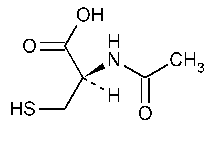Acetylcysteine
»Acetylcysteine contains not less than 98.0percent and not more than 102.0percent of C5H9NO3S,calculated on the dried basis.
Packaging and storage—
Preserve in tight containers,and store at controlled room temperature.
Identification,Infrared Absorption á197Kñ.
Specific rotation á781Sñ:
between +21 and +27
and +27 .
.
Test solution—
In a 25-mLvolumetric flask mix 1.25g with 1mLof edetate disodium solution (1in 100),add 7.5mLof sodium hydroxide solution (1in 25),and mix to dissolve.Dilute to volume with pH7.0buffer (prepared by mixing 29.5mLof 1Nsodium hydroxide,50mLof 1Mmonobasic potassium phosphate,and sufficient water to make 100mLand,using a pHmeter,adjusting to a pHof 7.0±0.1by adding,as necessary,more of either solution).
pHá791ñ:
between 2.0and 2.8,in a solution (1in 100).
Loss on drying á731ñ—
Dry it at a pressure of about 50mm of mercury at 70 for 4hours:it loses not more than 1.0%of its weight.
for 4hours:it loses not more than 1.0%of its weight.
Residue on ignition á281ñ—
Transfer to a tared fused silica dish about 2g,weigh accurately,heat on a hot plate until thoroughly charred,cool,add 1mLof sulfuric acid,and heat gently until fuming ceases.Ignite at 600 until the carbon is consumed.Not more than 0.5%is found.
until the carbon is consumed.Not more than 0.5%is found.
Heavy metals,Method IIá231ñ—
[Caution—Exercise care since explosion may occur.
]In a dropwise manner,wet the test specimen with 2mLof nitric acid,and proceed as directed for the Test Preparation:the limit is 0.001%.
Organic volatile impurities,Method Iá467ñ:
meets the requirements.
Assay—
Mobile phase—
Dissolve 6.8g of monobasic potassium phosphate in 1000mLof water,pass through a membrane filter having a 0.45-µm porosity,and degas.Adjust with phosphoric acid to a pHof 3.0.
Internal standard solution—
Dissolve about 1g of DL-phenylalanine in 200mLof freshly prepared sodium metabisulfite solution (1in 2000).
Standard preparation—
Dissolve an accurately weighed quantity of USP Acetylcysteine RSin sodium metabisulfite solution (1in 2000)to obtain a solution having a known concentration of about 10mg per mL.Pipet 10.0mLof this solution and 10.0mLof Internal standard solutioninto a 200-mLvolumetric flask,dilute with sodium metabisulfite solution (1in 2000)to volume,and mix to obtain a Standard preparationhaving a known concentration of about 0.5mg per mL.
Assay preparation—
Transfer about 1000mg of Acetylcysteine,accurately weighed,to a 100-mLvolumetric flask.Dissolve in sodium metabisulfite solution (1in 2000),dilute with the same solvent to volume,and mix.Pipet 10.0mLof this solution and 10.0mLof Internal standard solutioninto a 200-mLvolumetric flask,dilute with sodium metabisulfite solution (1in 2000)to volume,and mix.
Chromatographic system(see Chromatography á621ñ)—
The liquid chromatograph is equipped with a 214-nm detector and a 3.9-mm ×30-cm column that contains packing L1.The flow rate is about 1.5mLper minute.Chromatograph the Standard preparation,and record the peak responses as directed for Procedure:the relative standard deviation for replicate injections is not more than 2.0%;and the resolution,R,between acetylcysteine and DL-phenylalanine is not less than 6.
Procedure—
Separately inject equal volumes (about 5µL)of the Standard preparationand the Assay preparationinto the chromatograph,record the chromatograms,and measure the responses for the major peaks.The relative retention times are about 0.5for acetylcysteine and 1.0for DL-phenylalanine.Calculate the quantity,in mg,of C5H9NO3Sin the Acetylcysteine taken by the formula:
2000C(RU/RS),
in which Cis the concentration,in mg per mL,of USP Acetylcysteine RSin the Standard preparation;and RUand RSare the ratios of the peak response of acetylcysteine to that of DL-phenylalanine obtained from the Assay preparationand the Standard preparation,respectively.
Auxiliary Information—
Staff Liaison:Clydewyn M.Anthony,Ph.D.,Scientist
Expert Committee:(PA2)Pharmaceutical Analysis 2
USP28–NF23Page 46
Pharmacopeial Forum:Volume No.27(3)Page 2503
Phone Number:1-301-816-8139
